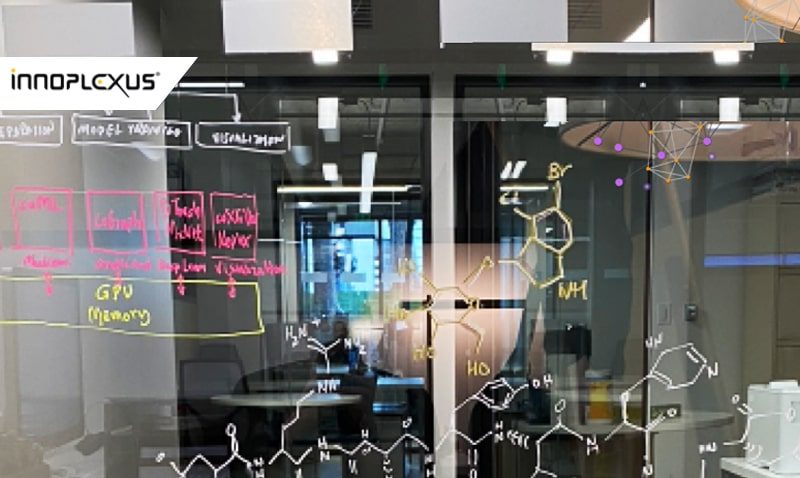
Ontosight® – Biweekly NewsletterJune 17th – June 30th, 2024 –Read More

Ontosight® – Biweekly NewsletterJune 17th – June 30th, 2024 –Read More
May 24
Apr 24

Innoplexus wins Horizon Interactive Gold Award for Curia App
Read More
At Innoplexus, I work with colleagues who have dedicated their lives and careers to drug discovery and life-sciences. They are biologists, physicians, data scientists and software engineers, armed with knowledge and creativity. We have developed AI capabilities that generate novel molecules to cure COVID-19 in a matter of days, with a single GPU. In the novel molecule insilco phase, less is more. From millions of generated candidate molecules, our technology identified a handful of the most promising ones. This is significantly better when compared to thousands of molecules generated by other super computers.
Our generative neural network consists of a variational auto-encoder with reinforcement learning running on a Tesla V100 SXM2 32GB board with DGX-1 GPUs. The reinforcement learning uses a reward module to quickly shuffle through millions of molecular candidates to identify the one that inhibits the target protein for COVID-19. With each iteration, the network learns how to create better molecules though the reward system. The data we used to train our neural network comes from publicly available literature, publications, congresses and patents, as ingested and distilled by the Innoplexus platform, Ontosight®.
We selected the most promising molecule that exhibits a strong binding affinity to the target protein, passed the drug-likeness rules including Lipinski rules of 5 and got top scores on all ADMET properties. Specifically, based on molecular docking studies, our candidate molecule [INM-124] shows a better binding affinity than existing drugs (such as Lopinavir). In addition, [INM-124] is orally bioavailable (including properties such as lipophilicity, water solubility, etc.) has high Gastro-Intestinal (GI) absorption, and produced zero alerts with respect to the Blood-Brain Barrier (BBB) permeation, Cytochrome P450 enzyme inhibition and toxicity including Cytotoxicity, Carcinogenicity, Hepatotoxicity, Immunotoxicity, etc. Finally, [INM-124], passed various heuristic rules of drug-likeness including Lipinski, Ghose, Veber, Egan, and Muegge.
The encoder includes a gated recurrent unit (GRU), responsible for storing the context of the generated molecules in the ‘simplified molecular-input line-entry system’ (SMILES) string. As a result, the GRU keeps on learning with each input and passes on the learned context to the next layer in the RNN while receiving the next SMILES candidate. Traditionally a GRU creates an NxM vector [N: Input vector size; M: number of hidden layers] for each step as it propagates through the RNN. Because SMILES vary in size, we are using a padding technique to generate the appropriate input for the GRU to function. As a result, the size of the GRU vector is NxMxP [N:Input vector size; M: number of hidden layers; P: Padding_size] out of which we use the portion of the vector that contains adequate context for the GRU to function. The decoder has a set of 7 dilated convolutional neural networks (CNN) to capture the context required to decode the SMILES as well as the relationships between atoms and bonds. During back-propagation, the decoder can generate better molecular structures.
The reinforced learning reward module consists of an ensemble of three self-optimizing-maps (SOM). The first SOM is trained to distinguish between molecules which are active and inactive against proteases, the class of the protein target. The second SOM is trained to select molecules which are the target protein inhibitors by mapping all the protease inhibiting molecules. The third SOM is trained to assess the novelty of the generated molecules as found in private and publicly available in chemical structures.
About Innoplexus
Innoplexus is an Industry validated, AI-powered, Drug Discovery and Development platform creating value for diverse stakeholders by driving Innovation in science, clinical development, and commercialization. Innoplexus is based in Frankfurt, Germany, with offices in India and USA.
The cost of developing a new drug roughly doubles every nine years (inflation-adjusted) aka Eroom’s law. As the volume of data…
There was a time when science depended on manual efforts by scientists and researchers. Then, came an avalanche of data…
Collaboration with key opinion leaders and influencers becomes crucial at various stages of the drug development chain. When a pharmaceutical…
Data are not the new gold – but the ability to put them together in a relevant and analyzable way…
Artificial intelligence, or AI, is gaining more attention in the pharma space these days. At one time evoking images from…
Artificial intelligence (AI) is transforming the pharmaceutical industry with extraordinary innovations that are automating processes at every stage of drug…
There is a lot of buzz these days about how artificial intelligence (AI) is going to disrupt the pharmaceutical industry….
Drug discovery plays a key role in the pharma and biotech industries. Discovering unmet needs, pinpointing the target, identifying the…
The pharmaceutical industry spends billions on R&D each year. Clinical trials require tremendous amounts of effort, from identifying sites and…
Training algorithms to identify and extract Life Sciences-specific data The English dictionary is full of words and definitions that can be…
The early 1970s introduced the world to the idea of computer vision, a promising technology automating tasks that would otherwise…
Summary: AI could potentially speed drug discovery and save time in rejecting treatments that are unlikely to yield worthwhile resultsAI has…